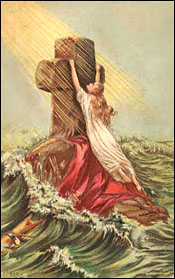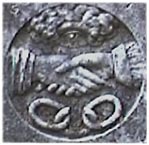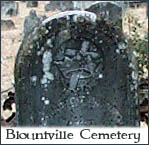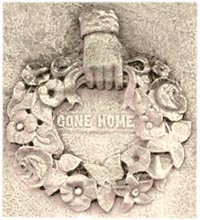
Rock of Ages

Christian Symbols on Grave Monuments
All-seeing Eye, Eye of God: Symbolizes the omnipresence of God. The Eye of God enclosed in a triangle represents the Holy Trinity. (Below: The All Seeing Eye of God, the two hands clasped represents farewell, and the chain with a broken link symbolizes the death of a family member.)

Anchor: Early Christian symbol of hope has been found in the art of the catacombs and may still be found on grave markers.
Cedar Tree: Symbolizes consecration.
Cross and Anchor: Early Christian symbol referring to Christ as “hope we have as an anchor of the soul, both sincere and steadfast” (Hebrews 6:19).
Cross, Crucifix: Symbolizes the mode of the death of Jesus Christ, and faith and resurrection; and it is considered the perfect symbol of Christ’s sacrifice in the Christian religion. It is the greatest Christian Sacred Symbol. Common variations include the Latin cross, the Greek cross, the Celtic cross, the Maltese cross, and the Russian or Eastern cross. Crosses can be found on tombs, as cross shaped ledger stones, freestanding gravemarkers, in ironworks, and as relief ornamentation.
Crown and Cross: These two icons together symbolize the reward of the faithful in the life after death for those who believe in the crucified Savior. “Be thou faithful unto death and I will give thee the Crown of Life.” ( Rev. 2:10)

Cypress Tree: Symbolizes mourning.
Flowers: Used to honor Christ and symbolize that He is “the Rose of Sharon, and the Lily of the Valleys.” (Song of Solomon 2:1). See the flowers on the Wreath below.
Heart encircled with Thorns: Symbolizes the suffering of Christ.
Heart Pierced by a Sword: Symbolizes the Virgin Mary, hearkening to Simeon’s prophecy to Mary at the birth of Christ, “Yea, a sword shall pierce through thine own soul.” (Luke 2:35)
Lamb: Symbolizes Christ in his sacrificial role and personifies innocence, gentleness and humility. Jesus, the Son of God, is the “Lamb of God, slain from the foundation of the world” for our sins, (Revelations 13:8). The Lamb is often found on the grave monuments of children.
Oak Tree: The oak considered as the tree from which the cross was made, it became a symbol of Christ. The Oak also symbolizes strength and renewal of life, and therefore, the Resurrection. The Oak tree was also a Druid symbol.
Olive Tree: Symbolizes peace.
Palm: Originally a military symbol of victory, it was adapted into Christianity as a symbol of Christ’s victory of death. Often seen as an attribute of martyrdom and eternal peace. Palms signifies praise, triumph and thanksgiving. They were borne in honor of Him and their homage accepted by Him on the first Palm Sunday.
Rock, (The Rock): Symbolizes Christ (“He is my rock...” - Psalm 92:15) or sometimes the Church. A ancient way to show the Rock was to have four streams of water flowing from it, the streams symbolizing the Four Gospels. The Rock could also represent St. Peter, and his successors. While we would not expect to often see a headstone with a Rock carved on its face, the Rock does occasionally serve as a monolithic monument. The Rock, from the song “Rock of Ages” has changed through the years to be become a rock cross. The illustration at the top of this page shows the Rock as the Cross, and there are grave markers that depict that scene in stone.
Rose: Associated with the Virgin Mary. In Catholic litanies, she is called “Rosa mystica” and in many hymns she is invoked as the “rose without thorns.” A red rose symbolizes martyrdom and a white rose symbolizes purity. See: Stone Rose
Trefoil: A three leaf clover or shamrock of sorts, symbolizes the Holy Trinity.
Wreath: Originally an ancient symbol of victory, it was adopted into the Christian religion as a symbol of the victory of the redemption. The hand holding the wreath (below) represents the hand of God.




